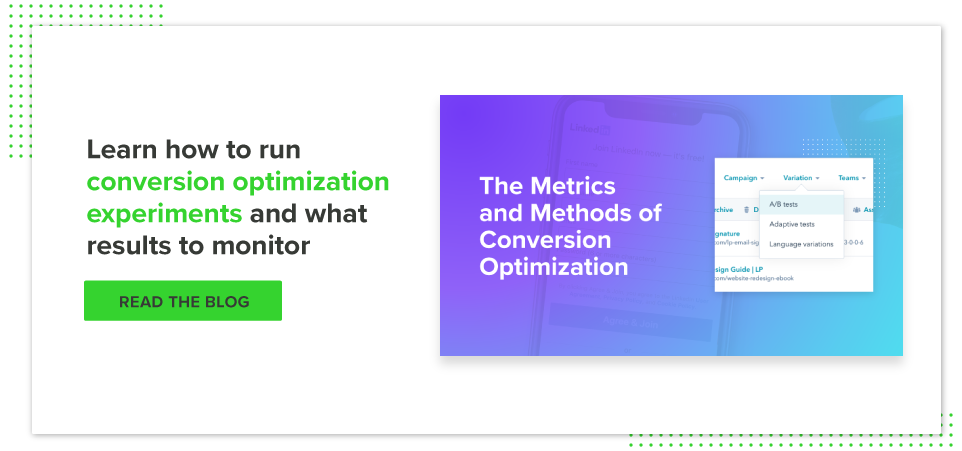3 Conversion Rate Optimization Steps Before Website Redesign
Nothing is more frustrating than investing tons of time and energy into your website, only to see dismal conversion rates. Every B2B marketer knows that your website should be your best salesperson. So when it’s underperforming, it’s easy to become discouraged. Many make the mistake of immediately assuming that a complete website overhaul is the only way to solve this problem, but that isn’t necessarily the case.
Conversion optimization practices can be easily and effectively implemented to address gaps in your funnel and ultimately drive revenue — all without having to carry out an extensive overhaul. Here are the three crucial conversion rate optimization steps to consider before resorting to a website redesign:
1. Have You Identified a Primary Key Performance Indicator (KPI)?
Do you know which conversion point is your top contributor to revenue? This is the single action that will convert a qualified visitor into an opportunity that sales can immediately follow-up on. Is it booking an assessment? Downloading a free trial? Requesting a personalized demo? Whatever action that may be, consider it your one true KPI.
If you feel like your conversion rates are underwhelming, it is important to consider the information influencing this assertion. Too many marketers make the critical mistake of not measuring a KPI or measuring the wrong one altogether. Identifying that top KPI will help you figure out the exact elements to optimize and prevent you from blindly making changes on your site in hopes that these changes will boost conversion. Moreover, it will ensure you measure the right metrics and utilize the most valuable data.
2. Do You Consistently Test Leading Performance Indicators (LPI) to Increase Conversion?
If you have an established KPI, do you implement testing on the LPIs that precede conversion on your KPI? LPIs are the micro-conversions that occur prior to completion of your one KPI. As their name implies, they're "leading" indicators. If they're all trending up, it's likely your KPI will, too. LPIs often take the form of middle-of-funnel content offers like template downloads or webinar registrations.
Have you made data-driven efforts to optimize these elements or have you gotten hung up on your troubling conversion rate? Upon seeing disappointing data, marketers often jump to the conclusion that they need a complete redesign without considering the lower-level changes that can boost conversion. What they don’t realize is that simple, calculated adjustments can be made to significant LPIs to potentially alleviate this issue. By consistently testing and experimentally changing these elements, you can identify and implement the changes that are most effective, further driving conversion on your KPI, and consequently, driving revenue.
Maybe you’re implementing experimental changes and conducting A/B testing on your LPIs, but you’re still not seeing favorable results. Are you sure that you’re using the right metrics to measure these efforts? All metrics are not created equal, and it’s easy to get caught up in tracking metrics that aren’t worth our attention. Be decisive when choosing your metrics. It’s essential to keep in mind that sometimes, less is actually more. Avoid falling victim to analysis paralysis by aligning your metrics with your goals. This will keep your measurement plan concise and prevent vanity metrics from clouding your data. A concise strategy will allow you to make data-driven decisions about LPI optimization.
3. Has It Been More Than a Year Since You Built a Sales-Ready Website?
A sales-ready website is a website built to drive conversion through inbound best practices. In many B2B industries, the actual transaction doesn’t necessarily take place on a company’s website, so many neglect to engineer their sites with sales readiness in mind.
Consider your last website redesign. Does your current site use persona-driven architecture? Are there clear paths to conversion on your KPI? Does it offer educational content that directly addresses the pain points of your buyer personas? Are your landing and thank you pages properly optimized?
Maybe your site incorporates these inbound best practices, but have you improved it at all since launch? Have you just let it sit untested with the dream of it working perfectly forever? Unfortunately, the reality is that the habits of consumers change almost constantly. What worked when you first launched your website probably won’t work as well several years down the road. With this in mind, it is essential to consistently implement changes and test for improvement.
If you haven’t had a sales-ready redesign within the past year, or ever, it’s likely that your low conversion rates stem from greater site elements that can’t be quickly fixed with conversion optimization. If you’ve established clear KPIs and are regularly experimentally changing and testing LPIs without seeing positive results, a full redesign might be your best option.
When Should You Opt for CRO?
If you answered “no” to any of the three big questions in this post, you are likely an excellent candidate for conversion optimization. Rather than going through the long-term process of a full redesign, use data-driven conversion optimization tactics that will allow you to identify quick wins to drive lead generation. These tactics can also help you track and measure the elements that affect your KPI — and ultimately, your revenue. Best of all, conversion optimization methods are inexpensive and simple to implement.
At New Breed, we leverage the principles of the scientific method (observe, hypothesize, experiment, measure) to enact changes that positively affect top-level KPI, and to track leading and tactical indicators that contribute to performance. No matter what your "one big thing" is, New Breed’s conversion optimization program has a data-driven approach to define, design and evaluate that chief metric.





